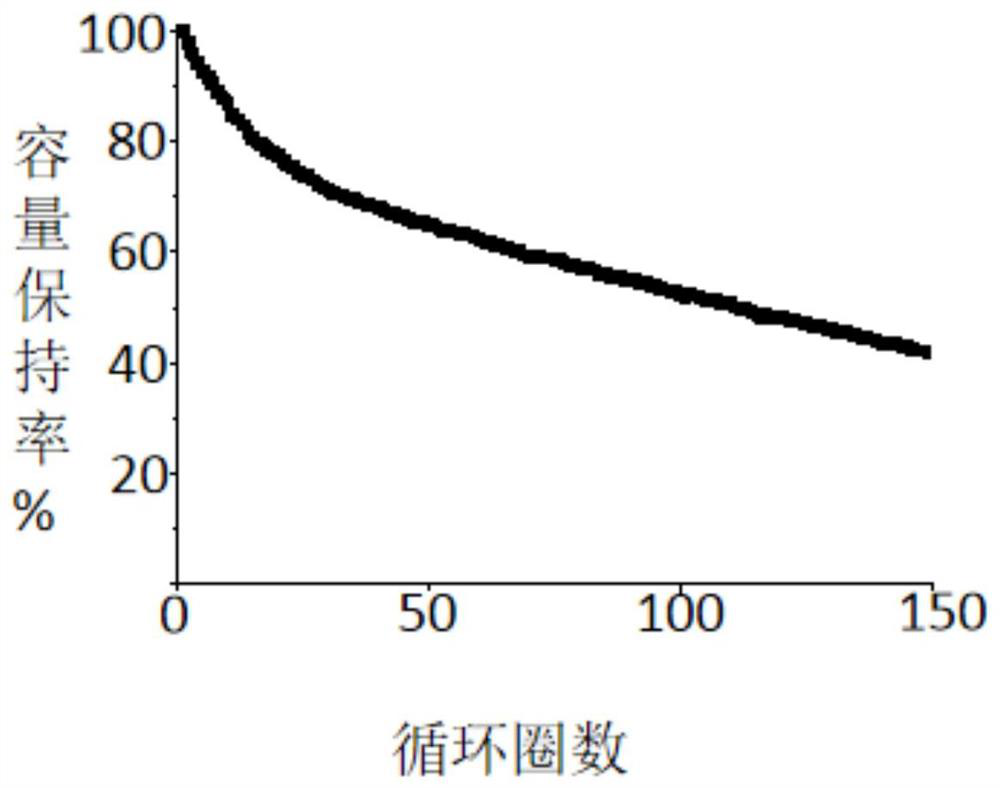Solid electrolyte for in-situ protection of metal lithium negative electrode and preparation method of solid electrolyte
A technology of solid electrolyte and metal lithium, which is applied in the direction of solid electrolyte, non-aqueous electrolyte, non-aqueous electrolyte battery, etc., can solve the problems of difficult research on electrode/polymer electrolyte interface, thin and uneven passivation film, etc. Growth of dendrites, strength enhancement, and damage prevention effects
- Summary
- Abstract
- Description
- Claims
- Application Information
AI Technical Summary
Problems solved by technology
Method used
Image
Examples
Embodiment 1
[0033] A solid electrolyte for in-situ protection of metal lithium negative electrodes, which is a double-salt solid electrolyte with both negative electrode protective agents and lithium salts;
[0034] Its components include by weight percentage: 5% of negative electrode protective agent, 5% of lithium salt, 10% of additive, 10% of plasticizer, and the balance is polymer base;
[0035] The polymer substrate is PEO;
[0036] The negative electrode protective agent is LiNO 3 ;
[0037] The lithium salt is LiPF 6 ;
[0038] The additive is silica nanoparticles;
[0039] Described plasticizer is succinonitrile;
[0040] The solid electrolyte for in-situ protection of the metal lithium negative electrode is obtained by dissolving the aforementioned negative electrode protective agent, lithium salt, additive, plasticizer, and polymer substrate in a solvent, followed by pouring and secondary drying;
[0041] The solvent is NN'-dimethylformamide, and its consumption is 2.5 times...
Embodiment 2
[0043] A solid electrolyte for in-situ protection of metal lithium negative electrodes, which is a double-salt solid electrolyte with both negative electrode protective agents and lithium salts;
[0044] Its components include by weight percentage: 10% of negative electrode protective agent, 10% of lithium salt, 15% of additive, 15% of plasticizer, and the balance is polymer base;
[0045] The polymer substrate is PEO;
[0046] The negative electrode protection agent is LiBOB;
[0047] The lithium salt is LiBF 4 ;
[0048] The additive is garnet-type nanoparticles;
[0049] Described plasticizer is succinonitrile;
[0050] The solid electrolyte for in-situ protection of the metal lithium negative electrode is obtained by dissolving the aforementioned negative electrode protective agent, lithium salt, additive, plasticizer, and polymer substrate in a solvent, followed by pouring and secondary drying;
[0051] The solvent is NN'-dimethylacetamide, and its consumption is 2 t...
Embodiment 3
[0053] A method for preparing a solid-state electrolyte for in-situ protection of lithium metal negative electrodes, comprising the steps of:
[0054] 1) Mix the polymer substrate, nitrogen-containing lithium nitrate salt, fluorine-containing lithium salt, additives, plasticizer and solvent evenly, and stir at a constant temperature of 55-65°C until the solution is clear and transparent;
[0055] 2) Cast the uniformly mixed solution onto a glass plate, and dry it in a constant temperature oven at 70-90°C to obtain a pre-dried polymer electrolyte film;
[0056] 3) Dry the pre-dried polymer electrolyte film in a vacuum oven at 48-56° C. for ≥ 4 hours.
PUM
 Login to View More
Login to View More Abstract
Description
Claims
Application Information
 Login to View More
Login to View More - R&D
- Intellectual Property
- Life Sciences
- Materials
- Tech Scout
- Unparalleled Data Quality
- Higher Quality Content
- 60% Fewer Hallucinations
Browse by: Latest US Patents, China's latest patents, Technical Efficacy Thesaurus, Application Domain, Technology Topic, Popular Technical Reports.
© 2025 PatSnap. All rights reserved.Legal|Privacy policy|Modern Slavery Act Transparency Statement|Sitemap|About US| Contact US: help@patsnap.com


